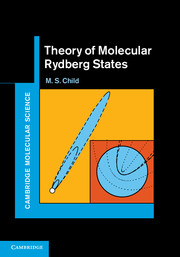Book contents
- Frontmatter
- Contents
- Preface
- 1 Molecular Rydberg states
- 2 The quantum defect picture
- 3 Ab-initio quantum defects
- 4 Frame transformations and channel interactions
- 5 Competitive fragmentation
- 6 Photo-excitation
- 7 Photo-ionization
- 8 Manipulating Rydberg states
- Appendix A MQDT normalization
- Appendix B Alternative MQDT representations
- Appendix C Rotational frame transformations
- Appendix D Optical transition and photo-ionization amplitudes
- Appendix E Generalized MQDT representation
- Appendix F Notation
- Index
- References
4 - Frame transformations and channel interactions
Published online by Cambridge University Press: 07 October 2011
- Frontmatter
- Contents
- Preface
- 1 Molecular Rydberg states
- 2 The quantum defect picture
- 3 Ab-initio quantum defects
- 4 Frame transformations and channel interactions
- 5 Competitive fragmentation
- 6 Photo-excitation
- 7 Photo-ionization
- 8 Manipulating Rydberg states
- Appendix A MQDT normalization
- Appendix B Alternative MQDT representations
- Appendix C Rotational frame transformations
- Appendix D Optical transition and photo-ionization amplitudes
- Appendix E Generalized MQDT representation
- Appendix F Notation
- Index
- References
Summary
The quantum defect and the frame transformation approximation are the two most important components of the MQDT machinery. This chapter starts by examining the validity of the latter approximation. To put the classical argument in Chapter 1 into a quantum mechanical perspective, Section 4.1 demonstrates the insensitivity of the radial wavefunction accompanying energy changes of the order of typical vibrational and rotational energy intervals. Readers who expect to apply the transformation at the core boundary may be surprised to find that it remains valid over often quite a wide range of radial separations, Δr, which varies inversely with the magnitude of the rotational or vibrational energy transfer involved.
A typical transformation element takes the form of the projection, 〈i|α〉 of an uncoupled state |i〉 onto a coupled Born–Oppenheimer state |α〉, the form of which varies according to the nature of the relevant motion. For example, in the rotational case |α〉 = |∧〉 is a specified body-fixed angular momentum projection, while |i〉 = |N+〉 is the positive ion angular momentum after the Rydberg electron has been uncoupled from the molecular frame. Section 4.2 restricts attention to the simplest angular momentum coupling case, with applications chosen to illustrate the quantum defect description of topics in the spectroscopic literature, such as ∧-doubling and ℓ-uncoupling [1, 2, 3]. The angular momentum manipulations required to handle more complicated coupling cases are treated in Appendix C, which also includes an account of the relevant parity and symmetry considerations.
- Type
- Chapter
- Information
- Theory of Molecular Rydberg States , pp. 90 - 124Publisher: Cambridge University PressPrint publication year: 2011



